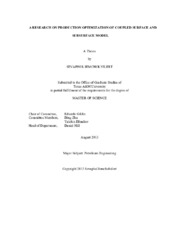| dc.description.abstract | One of the main objectives in the Oil & Gas Industry is to constantly improve the reservoir management capabilities by using production optimization strategies that can positively impact the so-called net-present value (NPV) of a given project. In order to achieve this goal the industry is faced with the difficult task of maximizing hydrocarbon production and minimizing unwanted fluids, such as water, while sustaining or even enhancing the reservoir recovery factor by handling properly the fluids at surface facilities. A key element in this process is the understanding of the interactions between subsurface and subsurface dynamics in order to provide insightful production strategies which honor reservoir management surface facility constraints. The implementation of the ideal situation of fully coupling surface/subsurface has been hindered by the required computational efforts involved in the process. Consequently, various types of partially coupling that require less computational efforts are practically implemented. Due to importance of coupling surface and subsurface model on production optimization and taking the advantage of advancing computational performance, this research explores the concept of surface and subsurface model couplings and production optimization.
The research aims at demonstrating the role of coupling of surface and subsurface model on production optimization under simple production constraint (i.e. production and injection pressure limit). The normal production prediction runs with various reservoir description (homogeneous-low permeability, homogeneous-high permeability, and heterogeneous permeability) and different fluid properties (dead-oil PVT and lived-oil PVT) were performed in order to understand the effect of coupling level, and coupling scheme with different reservoir descriptions and fluid properties on production and injection rate prediction. The result shows that for dead-oil PVT, the production rate from different coupling schemes in homogeneous and heterogeneous reservoir is less sensitive than lived-oil PVT cases. For lived-oil PVT, the production rate from different coupling schemes in homogeneous high permeability and heterogeneous permeability are more sensitive than homogeneous low permeability. The production optimization on water flooding under production and injection constraint cases is considered here also. | en |


